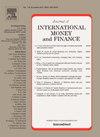A Markov-switching dynamic factor framework for dating global economic cycles
IF 2.8
2区 经济学
Q2 BUSINESS, FINANCE
引用次数: 0
Abstract
An important issue in identifying global recessions is the limited availability of output data at the quarterly and monthly frequencies over longer time horizons. A related issue is the heterogeneity in evidence about specific recessionary episodes. We utilize the context that commodity prices are determined in the global markets, and four base metals have flexible nominal prices at the monthly frequency from the 1960s. We use the base metal prices to supplement the information about the global economy in the GDP data of 32 countries and the World Industrial Production index. We estimate the quarterly episodes of global recessions from the 1960s using extended Markov-switching dynamic factor models with multiple indicators. We further adapt the quarterly models to a mixed-frequency Markov-switching dynamic factor model to estimate the monthly episodes. Our estimates show eight episodes of global recessions at the quarterly frequency. Monthly estimates also capture the eight quarterly episodes of global recessions. The results are robust to several model and data sensitivity analyses. Regressions using 32 countries show reductions in GDP growth for all countries during the global recession episodes. Further analysis shows that the four global recessions that are common with other studies are deeper and more widespread recessions than the other four downturns. The analysis highlights heterogeneity in the size and the spread of global recessions while providing empirical evidence in favor of four specific recessions with mixed support in the past literature.
预测全球经济周期的马尔可夫转换动态因子框架
识别全球衰退的一个重要问题是,在较长时间内,季度和月度产出数据的可用性有限。一个相关的问题是,关于具体衰退事件的证据存在异质性。我们利用了商品价格由全球市场决定的背景,四种基本金属的名义价格从20世纪60年代以来每月都有弹性。我们用基本金属价格来补充32个国家的GDP数据和世界工业生产指数中的全球经济信息。我们使用扩展的马尔可夫切换多指标动态因子模型估计了20世纪60年代以来全球经济衰退的季度周期。我们进一步将季度模型调整为混合频率马尔可夫开关动态因子模型来估计月度事件。我们的估计显示,按季度频率计算,全球出现了8次衰退。月度估计也反映了全球经济衰退的8个季度。结果对几种模型和数据敏感性分析具有鲁棒性。对32个国家的回归分析显示,在全球经济衰退期间,所有国家的GDP增长都有所下降。进一步的分析表明,在其他研究中常见的四次全球衰退比其他四次衰退更深、范围更广。该分析强调了全球衰退规模和蔓延的异质性,同时提供了支持过去文献中混合支持的四种特定衰退的经验证据。
本文章由计算机程序翻译,如有差异,请以英文原文为准。
求助全文
约1分钟内获得全文
求助全文
来源期刊

Journal of International Money and Finance
BUSINESS, FINANCE-
CiteScore
4.20
自引率
4.00%
发文量
141
期刊介绍:
Since its launch in 1982, Journal of International Money and Finance has built up a solid reputation as a high quality scholarly journal devoted to theoretical and empirical research in the fields of international monetary economics, international finance, and the rapidly developing overlap area between the two. Researchers in these areas, and financial market professionals too, pay attention to the articles that the journal publishes. Authors published in the journal are in the forefront of scholarly research on exchange rate behaviour, foreign exchange options, international capital markets, international monetary and fiscal policy, international transmission and related questions.
 求助内容:
求助内容: 应助结果提醒方式:
应助结果提醒方式:


